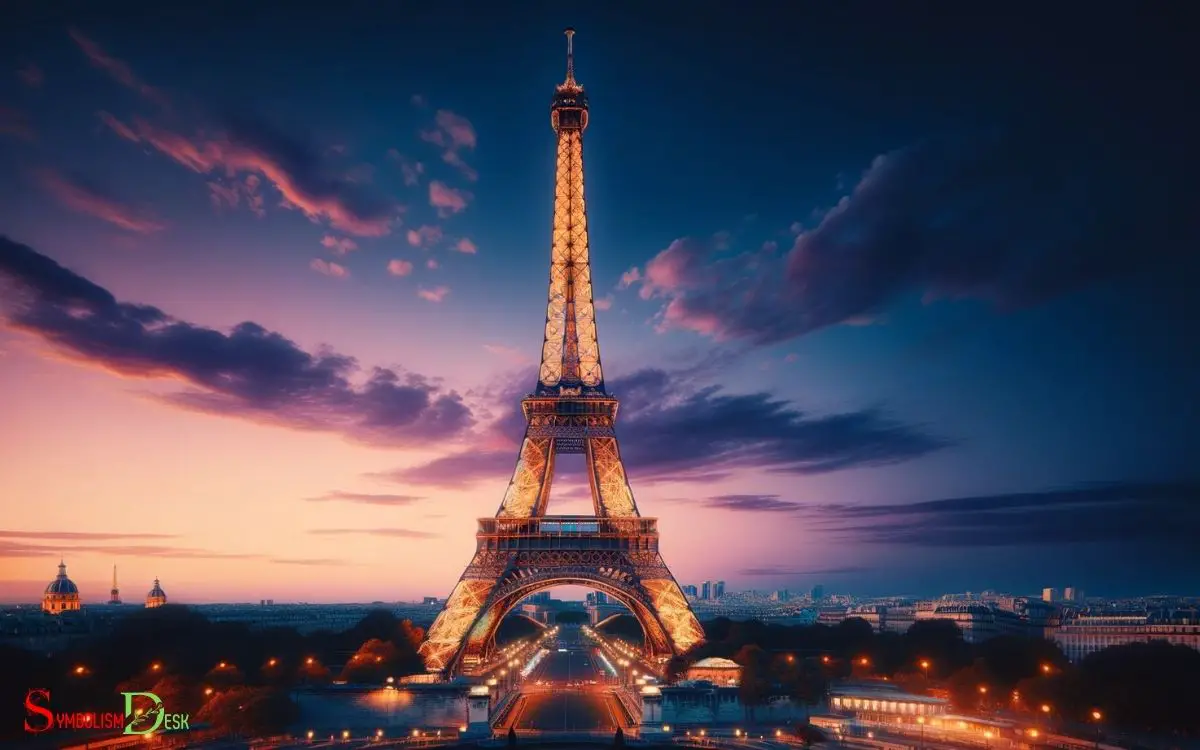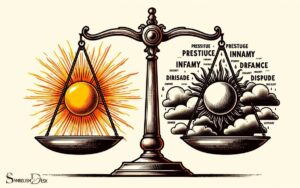What Is the Symbolic Meaning of the Eiffel Tower? Ingenuity!
The Eiffel Tower is a global icon of France and symbolizes human ingenuity, the spirit of the Belle Époque, and the allure of Paris as a city of romance and culture.
Recognized worldwide, the Eiffel Tower is not just a feat of engineering but a powerful emblem of French identity and a source of inspiration for artists, writers, and dreamers around the globe.
The Eiffel Tower holds symbolic significance for various reasons:
- Historical Significance: Completed in 1889, it commemorates the centennial of the French Revolution and showcases the industrial prowess of that era.
- Cultural Icon: It represents the artistic and cultural dynamism of France, particularly Paris.
- Romantic Emblem: Known as the ‘City of Love,’ Paris, with the Eiffel Tower at its heart, symbolizes romance, making it a popular destination for couples.
- Architectural Marvel: As a marvel of 19th-century engineering, it embodies human potential in design and construction.
- International Fame: It serves as a beacon of global recognition, attracting millions of visitors from around the world annually.
The Eiffel Tower stands as an enduring legacy of French elegance and engineering excellence, captivating the hearts of visitors and locals alike.

Key Takeaway
Historical Significance
While the Eiffel Tower is now a globally recognized symbol of France, it initially faced opposition from Parisians.
When Gustave Eiffel proposed the tower for the 1889 World’s Fair, many locals protested its construction, deeming it an eyesore that didn’t fit into the city’s architectural landscape.
However, as time passed, the tower’s historical significance became undeniable. It served as a temporary radio tower, intercepted crucial enemy communications during World War I, and was a crucial tool for scientific experiments.
Over the years, it has evolved into a cherished symbol of Paris and France, attracting millions of visitors annually. This historical journey from rejection to adoration highlights the profound impact the Eiffel Tower has had on French culture and identity.
This historical journey sets the stage for delving into the architectural symbolism of the Eiffel Tower.
Architectural Symbolism
The Eiffel Tower’s design holds significant architectural symbolism, reflecting the era in which it was constructed and its influence on subsequent architectural movements.
Its historical and cultural significance also plays a vital role in understanding the broader context of its architectural symbolism.
Furthermore, the Eiffel Tower’s influence on architecture extends beyond its initial construction, shaping the way structures are designed and perceived.
Eiffel Tower’s Design
Constructed by Gustave Eiffel in the late 19th century, the Eiffel Tower is a masterpiece of design that showcases intricate ironwork and geometric shapes.
Its lattice-like pattern of the iron framework, groundbreaking for its time, not only provides structural stability but also creates a visually captivating facade.
The use of geometric shapes, such as arches and triangles, adds to the tower’s aesthetic appeal and symbolizes mathematical precision and engineering prowess.
The design’s open structure allows natural light to permeate the tower during the day, resulting in ever-changing patterns of light and shadow.
These design elements collectively represent the technological advancements and artistic innovation of the era, making the Eiffel Tower a timeless icon of modernity.
Transitioning into the subsequent section about its historical and cultural significance, the Eiffel Tower’s design is deeply intertwined with its symbolic meaning and societal impact.
Historical and Cultural Significance
An important aspect of the Eiffel Tower’s symbolic significance lies in its historical and cultural impact as an architectural marvel representing progress and innovation in late 19th-century France.
Constructed for the 1889 World’s Fair, it became a powerful symbol of France’s industrial prowess and modernity.
At that time, the tower’s unprecedented height and daring design captured the imagination of the world, signifying France’s emergence as a global leader in science, engineering, and commerce.
The tower’s construction also coincided with the Belle Époque, a period of optimism and cultural flourishing in France.
As a result, the Eiffel Tower embodies not only architectural ingenuity but also the spirit of a nation advancing into the modern era, making it a timeless emblem of progress and cultural achievement.
Influence on Architecture
Representing a shift in architectural approaches, the Eiffel Tower’s construction had a significant impact on subsequent designs, inspiring a wave of innovative structures across the globe.
The Tower’s unprecedented use of iron as a construction material and its distinctive lattice structure revolutionized architectural possibilities, influencing the development of modern engineering and design principles.
Architects and engineers worldwide drew inspiration from its open framework, leading to the emergence of new construction techniques and the creation of iconic landmarks such as the Chrysler Building in New York City and the Tokyo Tower in Japan.
The Eiffel Tower’s daring design challenged traditional architectural norms, encouraging a departure from heavy, solid structures towards lighter, more ethereal forms, paving the way for the architectural experimentation that characterizes contemporary city skylines.
This influence on architecture reflects the enduring significance of the Eiffel Tower as a symbol of innovation and progress in the field of design.
Now, let’s delve into its impact on cultural representation.
Cultural Representation
The Eiffel Tower stands as an iconic French landmark and a symbol of global architectural influence.
Its cultural representation extends beyond its physical presence, embodying the essence of romance and elegance.
Understanding the significance of the Eiffel Tower in cultural representation unveils its impact on societies around the world.
Iconic French Landmark
The Eiffel Tower serves as a prominent symbol of French culture and heritage, encapsulating the essence of Parisian identity. It stands as a testament to French artistic and engineering prowess, symbolizing the country’s innovative spirit and commitment to architectural excellence.
The iconic landmark represents a historical landmark, embodying the rich history and tradition of France. It serves as a global icon of romance and love, attracting millions of visitors annually who seek to experience the enchanting ambiance of Paris.
The Eiffel Tower also signifies French national pride, evoking a sense of patriotism and unity among the French people.
- Testament to French artistic and engineering prowess
- Representation of historical landmark and tradition
- Global icon of romance and love
- Symbol of French national pride
- Evokes a sense of patriotism and unity among the French people
Global Architectural Influence
With its widespread recognition and influence, the Eiffel Tower has become a cultural symbol that extends far beyond the borders of France. Its architectural design has influenced numerous structures around the world, serving as a source of inspiration for architects and engineers.
The table below highlights some of the global architectural influences of the Eiffel Tower, showcasing its impact on iconic landmarks and structures worldwide.
| Landmark/Structure | Location |
|---|---|
| Statue of Liberty | New York, USA |
| Tokyo Tower | Tokyo, Japan |
| Blackpool Tower | Blackpool, England |
These structures, each with their own unique cultural significance, demonstrate the Eiffel Tower’s global influence and its ability to transcend boundaries, serving as a testament to the enduring impact of its design.
Symbol of Romance
Symbolizing love and romance, the Eiffel Tower frequently serves as a cultural representation of passion and affection, extending its influence beyond architecture to evoke emotions and connections.
- Proposal Location: Many couples choose the Eiffel Tower as a proposal location due to its romantic ambiance and symbolic significance.
- Wedding Venue: The Eiffel Tower is a popular choice for weddings, symbolizing eternal love and commitment.
- Romantic Getaways: It’s a favored destination for romantic getaways, offering breathtaking views and an enchanting atmosphere.
- Artistic Inspiration: The tower has inspired numerous artists, writers, and filmmakers, becoming synonymous with romantic storytelling.
- Symbol of Love: As a globally recognized symbol of love, the Eiffel Tower represents the enduring power of romance and the allure of Paris as the city of love.
Artistic Influence
An artistic influence that can be observed in the design of the Eiffel Tower is its incorporation of intricate ironwork, which has inspired countless architects and artists worldwide.
The use of iron lattice in the construction of the tower created a delicate yet sturdy aesthetic that revolutionized architectural and artistic thinking of the time.
This influence can be seen in various forms of art and architecture across the globe, with many structures borrowing elements of the Eiffel Tower’s intricate design.
The following table illustrates specific examples of artistic influence inspired by the Eiffel Tower:
| Artistic Influence | Description |
|---|---|
| Architecture | Many buildings incorporate iron lattice designs. |
| Sculpture | Artists use similar intricate patterns in sculptures. |
| Jewelry Design | The tower’s ironwork has influenced jewelry patterns. |
| Interior Decor | Iron lattice patterns are used in interior decorations. |
| Painting | Artists depict the tower’s ironwork in their paintings. |
The Eiffel Tower’s artistic influence continues to resonate across various artistic disciplines, shaping the way artists and architects approach design and construction.
Romantic Connotations
The Eiffel Tower’s graceful silhouette and intricate ironwork have captivated romantics worldwide, evoking a sense of passion and allure. Its romantic connotations are deeply rooted in history and culture, symbolizing love, beauty, and timeless elegance.
The tower’s association with romance is further heightened by the following:
- Proposal hotspot: The Eiffel Tower is a popular spot for marriage proposals, adding to its romantic allure.
- Literary inspiration: Renowned authors like Hemingway and Fitzgerald have incorporated the tower into their romantic works, perpetuating its amorous symbolism.
- Iconic backdrop: The tower’s presence in countless romantic films and artworks has solidified its status as a symbol of love and romance.
- Romantic rendezvous: Couples flock to the Eiffel Tower to celebrate their love, making it a magnet for romantic escapades.
- Timeless love symbol: The tower’s enduring presence has made it a timeless symbol of love and passion.
This romantic allure seamlessly transcends into its global iconography, further solidifying its significance on the world stage.
How Does the Symbolic Meaning of a Lighthouse Compare to the Symbolic Meaning of the Eiffel Tower?
The symbolic meaning of lighthouse represents guidance and safety, as it helps ships navigate through the darkness. On the other hand, the Eiffel Tower symbolizes romance, art, and architecture. While both are iconic structures, the lighthouse’s symbolism lies in protection, while the Eiffel Tower embodies love and creativity.
Global Iconography
The Eiffel Tower’s global iconography extends its romantic allure, making it a widely recognized symbol of love and romance around the world.
Its elegant silhouette has become synonymous with romance, and its global recognition as a symbol of love has made it an iconic backdrop for proposals, weddings, and romantic gestures.
The tower’s status as a global icon of love is evident in its frequent depiction in popular culture, from movies and television to literature and art.
Its presence in romantic narratives has solidified its status as a universal symbol of love, transcending cultural and linguistic barriers.
The Eiffel Tower’s global iconography as a symbol of love and romance has cemented its place as an enduring emblem of affection and passion worldwide.
Conclusion
The Eiffel Tower holds great symbolic meaning as a historical, architectural, and cultural icon. Standing at 1,063 feet, the tower attracts over 7 million visitors annually, making it one of the most visited monuments in the world.
Its influence on art, literature, and romanticism has solidified its status as a global symbol of love and beauty.






